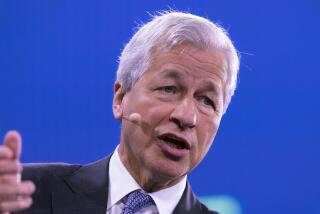Long-Term Capital, in Survival Mode, Begins Selling Assets
NEW YORK — Long-Term Capital Management, the huge private investment fund on life support after a $3.5-billion capital infusion, on Friday began selling assets in a bid to stay alive. But bankers warned that the liquidation will be a tortuous process.
Meanwhile, lawmakers said the Federal Reserve Board may not be doing enough to make sure that U.S. financial institutions are operating safely when they lend to and invest in so-called hedge funds.
“If they are looking at it, then there must be more thorough disclosure of the risk associated with these investments,” said Rep. Richard H. Baker, a Louisiana Republican who chairs the House Capital Markets subcommittee.
Baker’s concerns come a week after Federal Reserve Chairman Alan Greenspan told Congress that hedge funds, largely unregulated investment funds for well-heeled investors, don’t pose an overall risk to world financial markets.
Yet on Wednesday, Greenspan’s comments seemed to ring hollow after the New York Fed Bank oversaw an emergency bailout of Long-Term Capital--to be funded by major brokerages and banks--to avoid the risk of rocking the financial system with the fund’s losses.
On Friday, Treasury Secretary Robert E. Rubin announced that the government agencies responsible for supervising markets will prepare a study of hedge funds and “their relationships with their creditors.”
House Banking Committee Chairman James A. Leach, (R-Iowa), said that “questions exist as to whether appropriate national and international supervision exists” over hedge funds and as to “the role of speculative trading in the global economy.”
Leach asked Greenspan, Rubin, New York Fed President William McDonough and heads of other agencies to explain how they monitor investments in hedge funds. The committee will hold a hearing next week.
On Friday, Greenwich, Conn.-based Long-Term Capital, run by bond whiz John Meriwether, put the most liquid assets in its highly leveraged, $80-billion-plus portfolio on the block, selling Danish government and mortgage bonds and other European securities.
The consortium of 14 banks now overseeing and reorganizing the recapitalized fund said in a statement that they aim “over time, to reduce excessive risk exposures and leverage, return capital to the participants and realize the potential value of the portfolio.”
“The greatest worry on Wall Street is the fund’s equity derivatives portfolio,” said a banker who did not want to be identified.
Also Friday, credit rating agencies Moody’s Investors Service and Standard & Poor’s said they were reviewing all major U.S. and European banks for possible downgrade.
“We’re scrutinizing every bank with emerging-markets exposures, hedge fund exposures and other types of risky assets that could be impacted by these huge market movements,” said Christopher Mahoney, a Moody’s director.
Long-Term Capital’s troubles raised concerns that banks might pull back from all but the highest-quality borrowers, triggering a worldwide liquidity crunch.
“The credit cycle has definitely turned,” said Tanya Azarchs, director at Standard & Poor’s.
S&P; took the first shot at banks Friday by cutting its rating on Bankers Trust Corp. senior debt to A-minus from A. It cited the bank’s heavy dealings with riskier clients such as hedge funds.
Long-Term Capital has suffered large losses as its stock and bond bets went awry amid turmoil aggravated by Russia’s debt default, weakened Latin American markets and Asia’s continuing woes.
Several European banks have already taken hits from investments in Long-Term Capital. Dresdner Bank said Friday it would take a charge of $144 million to cover its stake in the fund. Credit Suisse Group said it had a loss of $55 million from counter-party exposure in a trade. Those announcements came after Swiss giant UBS said it would post a loss of $685 million on its equity stake in Long-Term.
More to Read
Inside the business of entertainment
The Wide Shot brings you news, analysis and insights on everything from streaming wars to production — and what it all means for the future.
You may occasionally receive promotional content from the Los Angeles Times.










